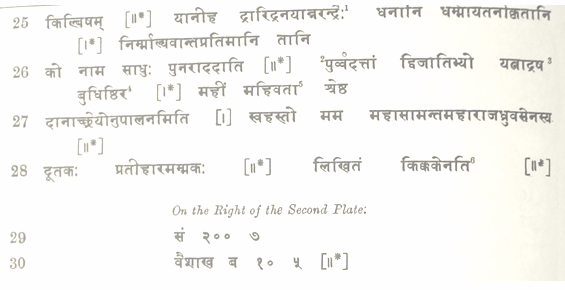|
The Indian Analyst
|
North Indian Inscriptions |
GANESGAD PLATES OF DHRUVASENA I.
TRANSLATION. ......(Line 1.) Ôṁ. Hail! From Valabhî.7
......(In the race) of the Maitrakas, who prostrated (their) enemies by force, (was born) the devout worshipper of Mahêśvara, the glorious general (sênâpati) Bhaṭârka, who obtained splendor in hundred of battles, fought with a vast crowd of enemies of unequalled strength ; who gained the devotion of these whom he had prostrated by (his) splendor, through (his) impartiality (in conferring) presents and honours ; (and) who acquired the glory of royalty by the strength of a devoted body of hereditary servants, hired soldiers, and friends. ......(L. 3.) His son (was) the devout worshipper of Mahêśvara, the general Dharasêna, whose bent head became purified as it was reddened by the dust of the feet of (his father) ;8 the splendor of whose toe-nails blended with the lustre if the crest-jewels on the bent heads of (his) enemies ; (and) whose wealth was being lived upon by distressed and helpless people. ......(L. 5.) His younger brother (was) the devout worshipper of Mahêśvara, the Mahârâja Drôṇasiṁha, whose spotless crest-jewel was (still more) purified (by his prostrations) at the feet of (his elder brother) ; who was by nature addicted to the performance of the duties prescribed by Manu and other (law-givers) ; who, like Dharmarâja (i.e. Yudhishṭhira), pointed out the path of the rules of good conduct ; the ceremony of whose anointment to the royalty was performed by His Majesty (paramasvâmin), the lord of the vast circle of the whole world, in person ; (and) who purified (his) royal glory by liberality. ......(L. 8.) His younger brother, the devout worshipper of Bhagavat, the Mahâsâmanta (and) Mahârâja Dhruvasêna,─ who meditated on the feet of His Majesty (paramabhaṭṭâraka) ;
who, like a lion,9 defeated alone, by the strength of his own arm, hosts of troops of enemies
(who resembled) elephants ; who was the refuge of those seeking refuge ; who knew the true
......1 Read
| ||||||||||||||||||||||||||||||||||||||||||||||||||||||||||||||||||||||||||||
| > |
|
>
|








